Abstract
This study investigates the relationship between clay minerals (kaolinite and illite) and rock properties of the claystone, including both mechanical (cohesion, friction angle, stress, and strain) and physical properties (natural water content, void ratio, and wet density), belonging to Warukin Formation of Kalimantan, Indonesia. Mineralogical characteristics of these rocks were studied using petrological and X-ray diffraction techniques, whereas the mechanical and physical properties were tested by conducting uniaxial and triaxial tests. Relationship among the variables was determined using correlation coefficients. It was observed that the mineralogy of the rocks pose strong constraints on their engineering properties. The results showed that an increase in illite content decreases cohesion, friction angle, strength, and safety factor; and increases natural moisture content, void ratio, and wet density. Although illite content of these rocks was just about 10.8% of the total minerals, it has significantly contributed to the modification of physical and mechanical properties. In contrast, kaolinite did not have a significant impact; since the correlation between various parameters was significantly low (correlation coefficient was much less, <0.3). Therefore while selecting the materials for geotechnical engineering applications, illite emerges as a safer alternative to kaolinite, especially when its concentration is less than 10.8% of the total rock mass.
1 Introduction
The correlation between clays and mechanical characteristics of claystone has been studied by many researchers [1, 2, 3] but the effect of the type of clay minerals on mechanical properties of rocks is poorly understood. However, change in the physical properties of the clastic sedimentary rocks can have a profound influence on their mechanical properties. They can substantially jeopardize the strength of these rocks and thereby their suitability for various engineering applications. Therefore, the minerals, especially clay minerals, pose strong constraints on mechanical strength of such clastic sedimentary rocks. Nevertheless, only few, if any, reports have so far been available on the types of minerals affecting the mechanical properties of rocks. It has been known that the physical property of clay minerals is a major factor for engineering design related to the behavior changes of the mechanical characteristics [4]. Several studies on montmorillonite have been carried out with respect to its application to engineering purposes, in particular for civil construction [5, 6]. However, there are no detailed studies on kaolinite and illite clays in relation to geotechnical properties;whether or not both clays have an important role in engineering design.
The reduction in strength of soft clays causes a decrease in bearing capacity and excessive settlement [7]. Kaolinite does not respond to chemical modifications but Na-smectite is highly sensitive to the variation of the chemistry of the pore fluid [8]. Lime-clay reactions depend on several factors such as mineralogical composition of clayey soil, the quantity of lime employed for treatment, and moisture content of the soil [9]. The strength parameters such as cohesion and friction angle of sand with clay mixture increases along with the increase in clay content. The resulting mixture can generally be considered dense for 10% of clay and greater. The increase in cohesion and internal friction angle is attributed to cementation and particle to particle contact, respectively [10]. Additional lime increases strength of clay materials. Montmorillonite responds much more rapidly to lime stabilization than kaolinite [11]. Ple et al. [12] also studied the numerical analysis of flexural behavior of clay layer, but the clay typeswere not studied in greater details. Similarly, characterization of marine clays was determined, however their correlation with mechanical properties was not attempted by these authors.
Among the swelling type of clays, bentonite was found to be more effective in reducing residual friction angle than kaolinite [13]. The mechanical responses in kaolinite depend on aggregate to aggregate interaction rather than particle to particle interactions. The aggregates of kaolinite can be considered analogous to sand particles [14]. Microstructure of clays is also one of the crucial factors that must be considered. Determination of microstructure level refers to [15] as follows:
Level 0: the scale of elementary clay layers
Level 1: the scale for which the elementary clay layers are packed together to form a clay particle or an aggregate
Level 2: the submicrometer scale, often called the microscopic scale of porous clay composites constituted in a mixture of clay particles or aggregate
Level 3: often called the macroscopic scale, is the scale of that characteristic size, the submillimeter range
According to the microstructure levels, the typical clay at the study area was expected to have level 3, since the materials were dominated by about 50% quartz. Illite is able to absorb more water compared to kaolinite, although much lesser than montmorillonite [16]. The rate of water absorption causes alteration of the mechanical characteristics of illite to become more responsive than kaolinite. Fabric in stratified clays in laboratory test depends on the type of mineralogy [17]. Type of clays affects axial strain and the peak axial strain increases when the distance with effective stress decreases [18]. The work of [19] has demonstrated that a degradation model for the shear modulus of soft clays corresponded to the following aspects: the number of cycles, the cyclic stress ratio, the loading frequency, and the plasticity index. All the aforementioned studies did not determine the effects of the type of clays. Hence, further investigation is required to determine the type of clays affecting the fabric of claystone, particularly the mechanical properties for geotechnical engineering purposes. Based on their structure, clay minerals can be divided into following 4 groups:
Kaolin ite (1:1)
Hydrous mica (2:1)
Montmorillonite (2:1)
Chlorite (2:2)
2 Materials and Method
2.1 Sampling and Mineralogical Characterization of Claystone
The claystone was obtained from Kusan Block, Tanah Bumbu regency, South Kalimantan province, Indonesia (see Fig. 1). This rock was grey to black in color, characterized by high water content due to high water level (5-10 m from surface). Samples were taken from slope face of coal mine areas, and claystone type was selected on the basis of visual description. Generally, a coal deposit is associated with fine-grained clastic sedimentary rocks, especially claystone and sandstone. The claystone was sampled using an undisturbed tube with a diameter of 70 mm and 50 cm in length, and then the samples were wrapped immediately to maintain its properties. A total of 35 samples was collected from all clay-stone outcrops and shipped to laboratory for further analysis. Sampling and sample handling were carried out as per the procedure of ASTM [20]. Mineralogical composition of the claystone was determined using X-ray powder diffraction analysis (XRD). The results indicate predominance of quartz, followed by kaolinite and illite (see Fig. 2). The clay-sized quartz with monocristalline habit has high hardness. Quartz content being homogeneous across the samples, can be ignored. Therefore, changes in the mechanical properties of rocks are influenced solely by the composition of clay minerals and changes in the physical properties of rocks. So the current emphasis was given to the clay minerals and the physical properties of rocks. Identification of clay mineral is done with a view to study the effect of clay minerals on the mechanical properties of the rocks.
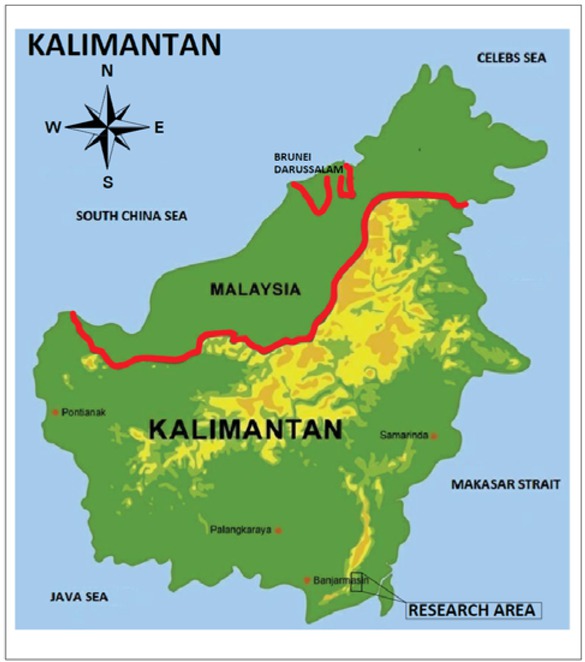
Study area in the Kusan Block, Tanah Bumbu Regency, South Kalimantan Province, Indonesia.
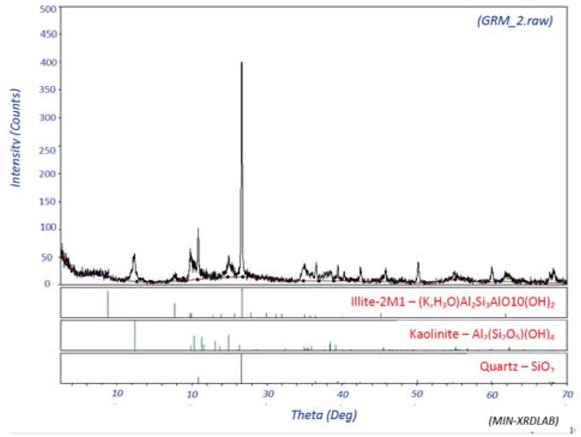
X-ray Diffraction pattern of the claystone used in this study.
2.2 Mechanical Characterization of Claystone
From 35 claystone samples, each sample was characterized for its mechanical properties including triaxial test, uniaxial test, moisture content, and density. Triaxial test was carried out to examine the strength and stress-strain relationships of cylindrical specimen of undisturbed samples. This is an important test for determination of the strength of rock in three dimensions [20]. A cylindrical specimen of a diameter of 3.3 cm and height to diameter ratio of 2–2.5 was selected for this study. Intrinsic Mohr curve was obtained from the triaxial test result, consisting of strength envelope, shear stress, friction angle, and cohesion.
Uniaxial test was conducted to determine the compressive stregth. A core sample was cut and ends were machine flat. Specimen sample was cylindrical having minimum diameter of 3.3 mm with height to diameter ratio of 2–2.5. The specimen was placed in a loading frame and compressed using uniaxial machine. Axial load was rapidly applied to the specimen and sustained. Deformation was monitored as a function of elapsed time. The uniaxial test results in the determination of compressive strength, elastic limit, modulus of elasticity, and Poisson ratio.
Similarly, moisture content test was determined in order to find out water content in the material mass. The water content is the percentage of ratio between water mass and specific gravity. The sample was oven dried at the temperature of ~110◦ ± 5◦ C in a constant condition until the sample was completely dried. The weight loss due to drying (loss on ignition (LOI)) is considered to be water. In addition to moisture content test, rock density was also measured in this study, which is a measure of mass per unit volume. There is a relationship between the density and strength of the rock as well as the void ratio. The higher the density, stronger the rock, and lower the void ratio. In addition, void ratio is the differential equation resulting from the water content calculation. Void ratio reflects the comparison of the void volume of the rock mass to the total volume of the rock mass, where void volume is expressed in percentage. The greater the void volume, greater is the pore volume in the rock mass. The void volume in the rock mass causes water or air to fill the pore, so that the pore pressure will increase and eventually rock strength will decrease.
3 Results and Discussion
To obtain a relationship between clays (in this case illite and kaolinite) and the mechanical and physical properties; scatter diagrams were constructed by plotting the clay content against the mechanical and physical properties, and their correlation coefficient (R) was computed. In principle, varying degrees of correlation are then represented by coefficients ranging from zero to 1 in either direction as follows: 0-0.19 (very low correlation), 0.2-0.39 (low correlation), 0.4-0.69 (medium correlation), 0.7-0.89 (strong correlation), 0.9-1 (very strong correlation) [21]. In other words, a coefficient of 1 indicates a perfect correlation between two variables and a coefficient of zero suggests a complete lack of correlation.
3.1 The Relationship Between Kaolinite - Illite and Physical Properties
A correlation between claystone physical properties (here natural water content) and illite or kaolinite content is given in Fig. 3. A strong correlation existed between natural water content and illite content
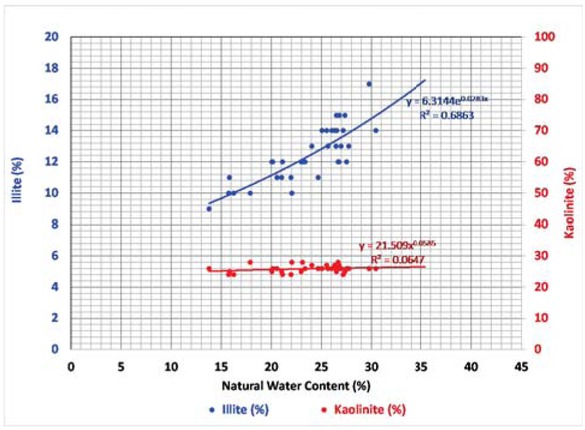
The relationship between natural water content (%) and the illite content or kaolinite content.
In case of physical properties, a strong negative correlation was observed between the wet density and illite
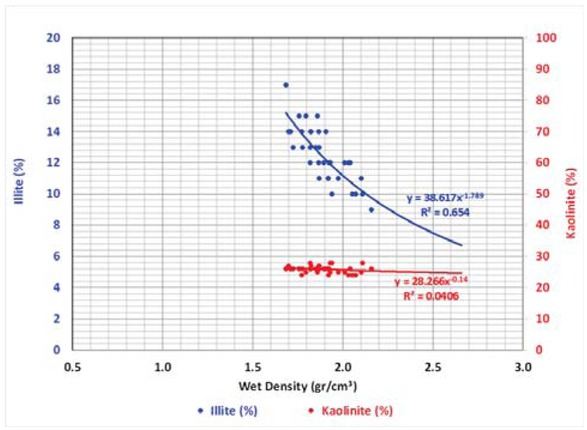
The relationship between wet density (kg/cm3) and the illite / kaolinite content.
3.2 The Relationship Between Kaolinite - Illite and Mechanical Properties
The relationship between cohesion value and illite or kaolinite content in claystone (see Fig. 5) was tested. It was observed that a strong negative correlation exists between cohesion and illite
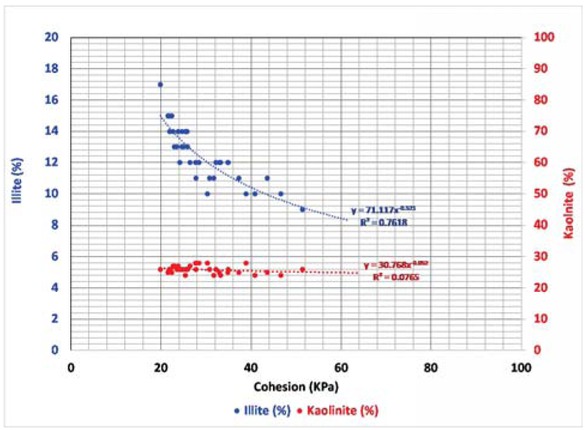
The relationship between the cohesion and the illite / kaolinite content.
Changes in claystone cohesion values are not affected by illite content alone, but also due to changes in physical properties such as changes in water content. It can be demonstrated that at the constant illite content, cohesion value decreases of claystone decreases due to water content, which forms identic patterns on the discrimination diagram (see Fig. 6). Therefore, F test regression is carried out on several variables that influence changes in cohesion value. Statistical test shows that every changes in cohesion value is affected by 34% water content and 18% illite content.
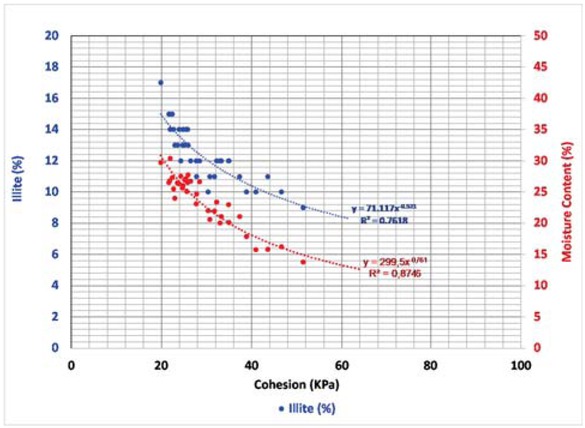
The relationship between the cohesion and the illite content as well as moisture content.
Another mechanical property affecting engineering applications is the friction angle (Phi); which is measured as the ability of a unit of rock or soil to withstand a shear stress. A strong negative correlation was observed between the friction angle and illite concentration
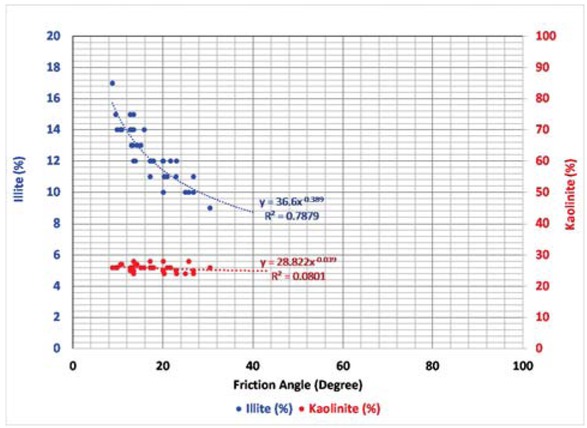
The relationship between the friction angle (◦) and the illite or kaolinite content.
angle was not significant. However, when illite clay content was <11%, the friction angle (3~6◦) increases significantly. In addition to friction angle, the strength (kPa) of the claystone was also determined (see Fig. 8). The results have indicated that there is a negative correlation between strength of material and the percentage of illite. That is, decrease in illite clay content increases the strength
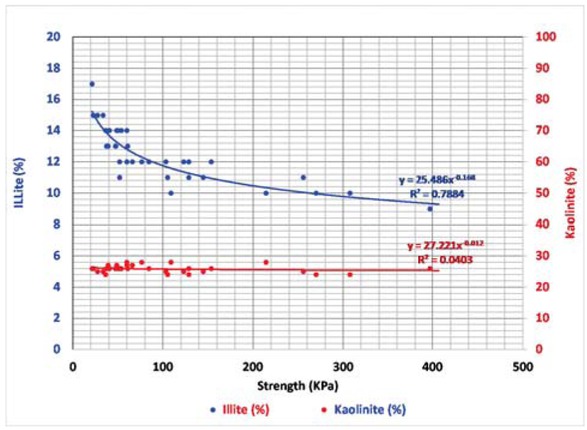
The relationship between the strength (kPa) and the illite or kaolinite content.
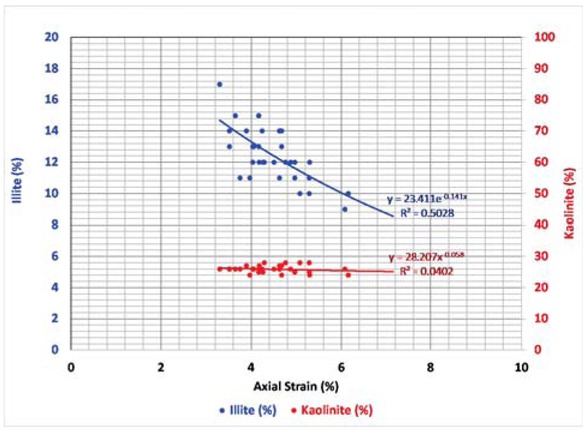
The relationship between the axial strain (%) and the illite or kaolinite content.
3.3 Role of Illite in Engineering Analysis & Road Settlement
The engineering analysis was also performed for road construction and hauling with soil embankment dominated by clay materials. The analysis was carried out at variable concentrations of illite such as 15%, 10.8%, and 8.5% (see Fig. 10). The mechanical properties that were tested includes cohesion value and friction angle by using clay-stone as an embankment base. In this case, the embankment analysis was conducted on stability value to get the value of safety factor and the value of vertical settlement on the road condition with a truck load of ~40 ton.
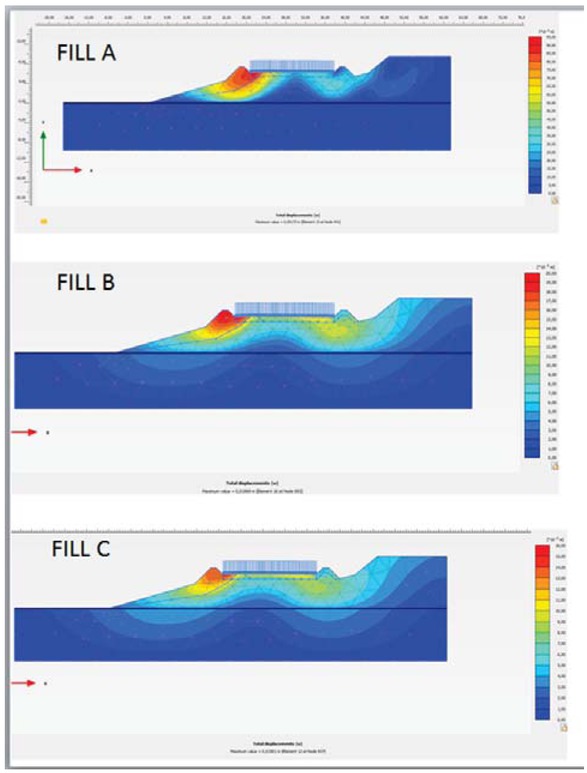
Images of road construction site showing hauling with soil embankment dominated by clay materials. Varying illite content of 15% (fill A), 10.2% (fill B), and 8.5% (fill C) are shown.
It was observed that the decrease in illite content results in increasing mechanical properties as important aspects in engineering analysis. It was shown in the engineering analysis that the decreased illite content was strongly correlated with an increase in safety factor values. Moreover, a very strong positive correlation existed between illite content and settlement value. On the road construction and hauling operations, the illite content should be controlled (see Fig. 11). It was observed that the roads constructed without consideration of illite content resulted in poor road quality (see Figs. 11(a)-11(b)). In the present study area, where clay minerals were the major constituents, layers having lower amount of illite produced good quality roads (see Figs. 11(c)-11(d)). Therefore the present study brings forth that the road construction of hauling could be undertaken by layering with materials containing a low amount of illite clay to acquire the better road quality.
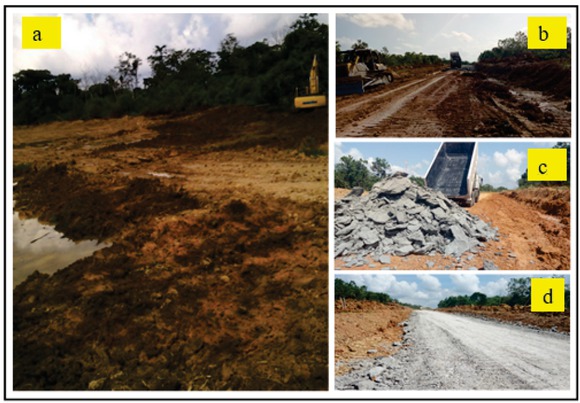
Preparation of connecting road from pit to phase 4 “layering road”.
4 Conclusion
Illite has a very strong relationship with the mechanical and physical characteristics of the claystones, whereas kaolinite remains neutral. The increased illite content corresponds to the decrease in cohesion, friction angle, strength, and axial strain of the claystone. The increased illite content also has significant effect on increase in water content, void ratio, and wet density. An increase in water content and void ratio is strongly correlated with the decreased mechanical characteristics of the claystone. In contrast, the kaolinite content is not correlated with cohesion, friction angle, strength, and axial strain; as well as water content, void ratio, and wet density. Engineering analysis has shown that the increased value of safety factor and settlement are strongly associated with the percentage of illite: the greater the illite content, the higher the settlement value and lower the safety value. It is suggested here that while selecting the construction materials involving clays, more attention should be paid to illite content; which should be less than 10.8% to obtain the optimum engineering results. This also confirms that the weaker materials such as claystones can also be used as embankment materials if the illite content is minimal (i.e. below 10.8%).
Based on statistical analysis, the changes in illite content contribute 18% and the changes in water content contribute 34% to changes in the mechanical properties of claystone. The illite content does not directly contribute to changes in mechanical properties, but the illite structure (2:1) allows physical properties of mineral to change fast, due to its water absorbing capacity. The water absorption process inhibits change in mechanical properties of minerals. Therefore mineralogical studies, especially microstructures of clays, has great significance in the engineering projects.
Acknowledgements
The authors would like to thank the management of PT Borneo Indobara, Indonesia, for supporting this research and allowing the publication of these results. Thanks are also due to RKDU Unpad 2017-2018 for supporting paper management and facilitating its publication.
References
[1] Plé, O.,Manicacci, A., Gourc, J.-P., Camp, S., Flexural behavior of a clay layer: Experimental and numerical study. Can. Geotech. J., 2012, vol. 49(4), 485-493.10.1139/t2012-006Search in Google Scholar
[2] Tiwari, B., Marui, H, Influences of clay mineralogy in residual shear strength of soil. Ann. Rep. of Res. Inst. for Hazards in Snowy Areas in Niigata Univ., 2002, vol. 24, 37-56.Search in Google Scholar
[3] Supandi, Zakaria, Z., Sukiyah, E., Sudradjat, A., The correlation of exposure time and claystone properties at the Warukin Formation Indonesia. International Journal of Geomate, 2018, vol. 15 (52), 188-195.10.21660/2018.52.68175Search in Google Scholar
[4] Benac, C., Oštrić, M., Jovančević, S.D., Geotechnical properties in relation to grain-size and mineral composition: The Grohovo landslide case study (Croatia). Geol. Croat., 2013, vol. 67(2), 127-136.10.4154/GC.2014.09Search in Google Scholar
[5] Bayesteh, H., Mirghasemi, A.A., Numerical simulation of pore fluid characteristic effect on the volume change behavior of montmorillonite clays. Comput. Geotech., 2013, vol. 48, 146-155.10.1016/j.compgeo.2012.10.007Search in Google Scholar
[6] Tembe, S., Lockner, D.A., Wong, T.-F., Effect of clay content and mineralogy on frictional sliding behavior of simulated gouges: Binary and ternary mixtures of quartz, illite, and montmorillonite. J. Geophys. Res. Sol. Ea., 2010, vol. 115, 22 p.10.1029/2009JB006383Search in Google Scholar
[7] Sakr, M.A., Shahin, M.A., Metwally, Y.M., Utilization of lime for stabilizing soft clay soil of high organic content. Geotechn. Geol. Eng., 2008, vol. 27, 105.10.1007/s10706-008-9215-2Search in Google Scholar
[8] Spagnoli, G., Fernandez-Steeger, T., Feinendegen, M., Stanjek, H., Azzam, R., The influence of the dielectric constant and electrolyte concentration of the pore fluids on the undrained shear strength of smectite. Soils Found., 2010, vol. 50(5), 757-763.10.3208/sandf.50.757Search in Google Scholar
[9] Sherwood, P., Soil Stabilization with Cement and Lime. TSO, London, 1993.Search in Google Scholar
[10] Al-Rawas, A.A., Mohamedzein, Y.E.A., Al-Shabibi, A.S., Al-Katheiri, S., Sand–attapulgite clay mixtures as a landfill liner. Geotechn. Geol. Eng., 2006, vol.24, 1365-1383.10.1007/s10706-005-2214-7Search in Google Scholar
[11] Bell, F.G, Lime stabilization of clay minerals and soils. Eng. Geol., 1996, vol. 42(4), 223-237.10.1016/0013-7952(96)00028-2Search in Google Scholar
[12] Plé, O., Tourabi, A., Abuaisha, M.S., 3-Dimensional digital image correlation for strains determination in clayey soil. Appl. Mech. Mater., 2013, vol. 353, 463-466.10.4028/www.scientific.net/AMM.353-356.463Search in Google Scholar
[13] Dimitrova, R.S., Yanful, E.K., Factors affecting the shear strength of mine tailings/clay mixtures with varying clay content and clay mineralogy. Eng. Geol., 2012, vol. 125, 11-25.10.1016/j.enggeo.2011.10.013Search in Google Scholar
[14] Yu, C.Y., Chow, J.K., Wang, Y.-H., Pore-size changes and responses of kaolinite with different structures subject to consolidation and shearing. Eng. Geol., 2006, vol. 202, 122-131.10.1016/j.enggeo.2016.01.007Search in Google Scholar
[15] Cosenza, P., Prêt, D., Giraud, A., Hedan, S., Effect of the local clay distribution on the effective elastic properties of shales. Mech. Mater., 2015, vol. 84, 55-74.10.1016/j.mechmat.2015.01.016Search in Google Scholar
[16] Yao, Q.-L., Zhang, F.-T., Ding, X.-L., Zhang, L., Jiang, G., Experimental research on instability mechanism of silty mudstone roofs under action of water and its application. Proc. Earth Planetary Sci., 2009, vol. 1(1), 402-408.10.1016/j.proeps.2009.09.064Search in Google Scholar
[17] Gumaste, S.D., Iyer, K.R., Sharma, S., Channabasavaraj, W., Singh, D.N., Simulation of fabric in sedimented clays. Appl. Clay Sci., 2014, vol. 91-92, 117–126.10.1016/j.clay.2014.01.011Search in Google Scholar
[18] Wang, J., Guo, L., Cai, Y., Xu, C., Gu, C, Strain and pore pressure development on soft marine clay in triaxial tests with a large number of cycles. Ocean Eng., 2013, vol. 74, 125-132.10.1016/j.oceaneng.2013.10.005Search in Google Scholar
[19] Zhou, J., Gong, X., Strain degradation of saturated clay under cyclic loading. Can. Geotechn. J., 2001, vol. 38, 208-212.10.1139/t00-062Search in Google Scholar
[20] ASTM D2850-95, Standard Test Method for Unconsolidated-Undrained Triaxial Compression Test on Cohesive Soils, ASTM International, United States, 1999.Search in Google Scholar
[21] Guilford, J.P., Fundamental Statistics in Psychology and Education. McGraw Hill, New York, 1956.Search in Google Scholar
[22] Plé, O., Lê, T.N.H., Effect of polypropylene fiber-reinforcement on the mechanical behavior of silty clay. Geotext. Geomembr., 2012, vol. 32, 111-116.10.1016/j.geotexmem.2011.11.004Search in Google Scholar
© 2019 Supandi Supandi et al., published by De Gruyter
This work is licensed under the Creative Commons Attribution 4.0 Public License.
Articles in the same Issue
- Regular Articles
- 2D Seismic Interpretation of the Meyal Area, Northern Potwar Deform Zone, Potwar Basin, Pakistan
- A new method of lithologic identification and distribution characteristics of fine - grained sediments: A case study in southwest of Ordos Basin, China
- Modified Gompertz sigmoidal model removing fine-ending of grain-size distribution
- Diagenesis and its influence on reservoir quality and oil-water relative permeability: A case study in the Yanchang Formation Chang 8 tight sandstone oil reservoir, Ordos Basin, China
- Evaluation of AHRS algorithms for Foot-Mounted Inertial-based Indoor Navigation Systems
- Identification and evaluation of land use vulnerability in a coal mining area under the coupled human-environment
- Hydrocarbon Generation Potential of Chia Gara Formation in Three Selected Wells, Northern Iraq
- Source Analysis of Silicon and Uranium in uranium-rich shale in the Xiuwu Basin, Southern China
- Lithologic heterogeneity of lacustrine shale and its geological significance for shale hydrocarbon-a case study of Zhangjiatan Shale
- Characterization of soil permeability in the former Lake Texcoco, Mexico
- Detrital zircon trace elements from the Mesozoic Jiyuan Basin, central China and its implication on tectonic transition of the Qinling Orogenic Belt
- Turkey OpenStreetMap Dataset - Spatial Analysis of Development and Growth Proxies
- Morphological Changes of the Lower Ping and Chao Phraya Rivers, North and Central Thailand: Flood and Coastal Equilibrium Analyses
- Landscape Transformations in Rapidly Developing Peri-urban Areas of Accra, Ghana: Results of 30 years
- Division of shale sequences and prediction of the favorable shale gas intervals: an example of the Lower Cambrian of Yangtze Region in Xiuwu Basin
- Fractal characteristics of nanopores in lacustrine shales of the Triassic Yanchang Formation, Ordos Basin, NW China
- Selected components of geological structures and numerical modelling of slope stability
- Spatial data quality and uncertainty publication patterns and trends by bibliometric analysis
- Application of microstructure classification for the assessment of the variability of geological-engineering and pore space properties in clay soils
- Shear failure modes and AE characteristics of sandstone and marble fractures
- Ice Age theory: a correspondence between Milutin Milanković and Vojislav Mišković
- Are Serbian tourists worried? The effect of psychological factors on tourists’ behavior based on the perceived risk
- Real-Time Map Matching: A New Algorithm Integrating Spatio-Temporal Proximity and Improved Weighted Circle
- Characteristics and hysteresis of saturated-unsaturated seepage of soil landslides in the Three Gorges Reservoir Area, China
- Petrographical and geophysical investigation of the Ecca Group between Fort Beaufort and Grahamstown, in the Eastern Cape Province, South Africa
- Ecological risk assessment of geohazards in Natural World Heritage Sites: an empirical analysis of Bogda, Tianshan
- Integrated Subsurface Temperature Modeling beneath Mt. Lawu and Mt. Muriah in The Northeast Java Basin, Indonesia
- Go social for your own safety! Review of social networks use on natural disasters – case studies from worldwide
- Forestry Aridity Index in Vojvodina, North Serbia
- Natural Disasters vs Hotel Industry Resilience: An Exploratory Study among Hotel Managers from Europe
- Using Monarch Butterfly Optimization to Solve the Emergency Vehicle Routing Problem with Relief Materials in Sudden Disasters
- Potential influence of meteorological variables on forest fire risk in Serbia during the period 2000-2017
- Controlling factors on the geochemistry of Al-Shuaiba and Al-Mejarma coastal lagoons, Red Sea, Saudi Arabia
- The Influence of Kaolinite - Illite toward mechanical properties of Claystone
- Two critical books in the history of loess investigation: ‘Charakteristik der Felsarten’ by Karl Caesar von Leonhard and ‘Principles of Geology’ by Charles Lyell
- The Mechanism and Control Technology of Strong Strata Behavior in Extra-Thick Coal Seam Mining Influenced by Overlying Coal Pillar
- Shared Aerial Drone Videos — Prospects and Problems for Volunteered Geographic Information Research
- Stable isotopes of C and H in methane fermentation of agriculture substrates at different temperature conditions
- Prediction of Compression and Swelling Index Parameters of Quaternary Sediments from Index Tests at Mersin District
- Detection of old scattered windthrow using low cost resources. The case of Storm Xynthia in the Vosges Mountains, 28 February 2010
- Remediation of Copper and Zinc from wastewater by modified clay in Asir region southwest of Saudi Arabia
- Sedimentary facies of Paleogene lacustrine dolomicrite and implications for petroleum reservoirs in the southern Qianjiang Depression, China
- Correlation between ore particle flow pattern and velocity field through multiple drawpoints under the influence of a flexible barrier
- Atmospheric refractivity estimation from AIS signal power using the quantum-behaved particle swarm optimization algorithm
- A geophysical and hydro physico-chemical study of the contaminant impact of a solid waste landfill (swl) in King Williams’ Town, Eastern Cape, South Africa
- Landscape characterization using photographs from crowdsourced platforms: content analysis of social media photographs
- A Study on Transient Electromagnetic Interpretation Method Based on the Seismic Wave Impedance Inversion Model
- Stratigraphy of Architectural Elements of a Buried Monogenetic Volcanic System
- Variable secondary porosity modeling of carbonate rocks based on μ-CT images
- Traditional versus modern settlement on torrential alluvial fans considering the danger of debris flows: a case study of the Upper Sava Valley (NW Slovenia)
- The Influence of Gangue Particle size and Gangue Feeding Rate on Safety and Service Life of the Suspended Buffer’s Spring
- Research on the Transition Section Length of the Mixed Workface Using Gangue Backfilling Method and Caving Method
- Rainfall erosivity and extreme precipitation in the Pannonian basin
- Structure of the Sediment and Crust in the Northeast North China Craton from Improved Sequential H-k Stacking Method
- Planning Activities Improvements Responding Local Interests Change through Participatory Approach
- GIS-based landslide susceptibility mapping using bivariate statistical methods in North-western Tunisia
- Uncertainty based multi-step seismic analysis for near-surface imaging
- Deformation monitoring and prediction for residential areas in the Panji mining area based on an InSAR time series analysis and the GM-SVR model
- Statistical and expert-based landslide susceptibility modeling on a national scale applied to North Macedonia
- Natural hazards and their impact on rural settlements in NE Romania – A cartographical approach
- Rock fracture initiation and propagation by mechanical and hydraulic impact
- Influence of Rapid Transit on Accessibility Pattern and Economic Linkage at Urban Agglomeration Scale in China
- Near Infrared Spectroscopic Study of Trioctahedral Chlorites and Its Remote Sensing Application
- Problems with collapsible soils: Particle types and inter-particle bonding
- Unification of data from various seismic catalogues to study seismic activity in the Carpathians Mountain arc
- Quality assessment of DEM derived from topographic maps for geomorphometric purposes
- Remote Sensing Monitoring of Soil Moisture in the Daliuta Coal Mine Based on SPOT 5/6 and Worldview-2
- Utilizing Maximum Entropy Spectral Analysis (MESA) to identify Milankovitch cycles in Lower Member of Miocene Zhujiang Formation in north slope of Baiyun Sag, Pearl River Mouth Basin, South China Sea
- Stability Analysis of a Slurry Trench in Cohesive-Frictional Soils
- Integrating Landsat 7 and 8 data to improve basalt formation classification: A case study at Buon Ma Thuot region, Central Highland, Vietnam
- Assessment of the hydrocarbon potentiality of the Late Jurassic formations of NW Iraq: A case study based on TOC and Rock-Eval pyrolysis in selected oil-wells
- Rare earth element geochemistry of sediments from the southern Okinawa Trough since 3 ka: Implications for river-sea processes and sediment source
- Effect of gas adsorption-induced pore radius and effective stress on shale gas permeability in slip flow: New Insights
- Development of the Narva-Jõesuu beach, mineral composition of beach deposits and destruction of the pier, southeastern coast of the Gulf of Finland
- Selecting fracturing interval for the exploitation of tight oil reservoirs from logs: a case study
- A comprehensive scheme for lithological mapping using Sentinel-2A and ASTER GDEM in weathered and vegetated coastal zone, Southern China
- Sedimentary model of K-Successions Sandstones in H21 Area of Huizhou Depression, Pearl River Mouth Basin, South China Sea
- A non-uniform dip slip formula to calculate the coseismic deformation: Case study of Tohoku Mw9.0 Earthquake
- Decision trees in environmental justice research — a case study on the floods of 2001 and 2010 in Hungary
- The Impacts of Climate Change on Maximum Daily Discharge in the Payab Jamash Watershed, Iran
- Mass tourism in protected areas – underestimated threat? Polish National Parks case study
- Decadal variations of total organic carbon production in the inner-shelf of the South China Sea and East China Sea
- Hydrogeothermal potentials of Rogozna mountain and possibility of their valorization
- Postglacial talus slope development imaged by the ERT method: comparison of slopes from SW Spitsbergen, Norway and Tatra Mountains, Poland
- Seismotectonics of Malatya Fault, Eastern Turkey
- Investigating of soil features and landslide risk in Western-Atakent (İstanbul) using resistivity, MASW, Microtremor and boreholes methods
- Assessment of Aquifer Vulnerability Using Integrated Geophysical Approach in Weathered Terrains of South China
- An integrated analysis of mineralogical and microstructural characteristics and petrophysical properties of carbonate rocks in the lower Indus Basin, Pakistan
- Applicability of Hydrological Models for Flash Flood Simulation in Small Catchments of Hilly Area in China
- Heterogeneity analysis of shale reservoir based on multi-stage pumping data
Articles in the same Issue
- Regular Articles
- 2D Seismic Interpretation of the Meyal Area, Northern Potwar Deform Zone, Potwar Basin, Pakistan
- A new method of lithologic identification and distribution characteristics of fine - grained sediments: A case study in southwest of Ordos Basin, China
- Modified Gompertz sigmoidal model removing fine-ending of grain-size distribution
- Diagenesis and its influence on reservoir quality and oil-water relative permeability: A case study in the Yanchang Formation Chang 8 tight sandstone oil reservoir, Ordos Basin, China
- Evaluation of AHRS algorithms for Foot-Mounted Inertial-based Indoor Navigation Systems
- Identification and evaluation of land use vulnerability in a coal mining area under the coupled human-environment
- Hydrocarbon Generation Potential of Chia Gara Formation in Three Selected Wells, Northern Iraq
- Source Analysis of Silicon and Uranium in uranium-rich shale in the Xiuwu Basin, Southern China
- Lithologic heterogeneity of lacustrine shale and its geological significance for shale hydrocarbon-a case study of Zhangjiatan Shale
- Characterization of soil permeability in the former Lake Texcoco, Mexico
- Detrital zircon trace elements from the Mesozoic Jiyuan Basin, central China and its implication on tectonic transition of the Qinling Orogenic Belt
- Turkey OpenStreetMap Dataset - Spatial Analysis of Development and Growth Proxies
- Morphological Changes of the Lower Ping and Chao Phraya Rivers, North and Central Thailand: Flood and Coastal Equilibrium Analyses
- Landscape Transformations in Rapidly Developing Peri-urban Areas of Accra, Ghana: Results of 30 years
- Division of shale sequences and prediction of the favorable shale gas intervals: an example of the Lower Cambrian of Yangtze Region in Xiuwu Basin
- Fractal characteristics of nanopores in lacustrine shales of the Triassic Yanchang Formation, Ordos Basin, NW China
- Selected components of geological structures and numerical modelling of slope stability
- Spatial data quality and uncertainty publication patterns and trends by bibliometric analysis
- Application of microstructure classification for the assessment of the variability of geological-engineering and pore space properties in clay soils
- Shear failure modes and AE characteristics of sandstone and marble fractures
- Ice Age theory: a correspondence between Milutin Milanković and Vojislav Mišković
- Are Serbian tourists worried? The effect of psychological factors on tourists’ behavior based on the perceived risk
- Real-Time Map Matching: A New Algorithm Integrating Spatio-Temporal Proximity and Improved Weighted Circle
- Characteristics and hysteresis of saturated-unsaturated seepage of soil landslides in the Three Gorges Reservoir Area, China
- Petrographical and geophysical investigation of the Ecca Group between Fort Beaufort and Grahamstown, in the Eastern Cape Province, South Africa
- Ecological risk assessment of geohazards in Natural World Heritage Sites: an empirical analysis of Bogda, Tianshan
- Integrated Subsurface Temperature Modeling beneath Mt. Lawu and Mt. Muriah in The Northeast Java Basin, Indonesia
- Go social for your own safety! Review of social networks use on natural disasters – case studies from worldwide
- Forestry Aridity Index in Vojvodina, North Serbia
- Natural Disasters vs Hotel Industry Resilience: An Exploratory Study among Hotel Managers from Europe
- Using Monarch Butterfly Optimization to Solve the Emergency Vehicle Routing Problem with Relief Materials in Sudden Disasters
- Potential influence of meteorological variables on forest fire risk in Serbia during the period 2000-2017
- Controlling factors on the geochemistry of Al-Shuaiba and Al-Mejarma coastal lagoons, Red Sea, Saudi Arabia
- The Influence of Kaolinite - Illite toward mechanical properties of Claystone
- Two critical books in the history of loess investigation: ‘Charakteristik der Felsarten’ by Karl Caesar von Leonhard and ‘Principles of Geology’ by Charles Lyell
- The Mechanism and Control Technology of Strong Strata Behavior in Extra-Thick Coal Seam Mining Influenced by Overlying Coal Pillar
- Shared Aerial Drone Videos — Prospects and Problems for Volunteered Geographic Information Research
- Stable isotopes of C and H in methane fermentation of agriculture substrates at different temperature conditions
- Prediction of Compression and Swelling Index Parameters of Quaternary Sediments from Index Tests at Mersin District
- Detection of old scattered windthrow using low cost resources. The case of Storm Xynthia in the Vosges Mountains, 28 February 2010
- Remediation of Copper and Zinc from wastewater by modified clay in Asir region southwest of Saudi Arabia
- Sedimentary facies of Paleogene lacustrine dolomicrite and implications for petroleum reservoirs in the southern Qianjiang Depression, China
- Correlation between ore particle flow pattern and velocity field through multiple drawpoints under the influence of a flexible barrier
- Atmospheric refractivity estimation from AIS signal power using the quantum-behaved particle swarm optimization algorithm
- A geophysical and hydro physico-chemical study of the contaminant impact of a solid waste landfill (swl) in King Williams’ Town, Eastern Cape, South Africa
- Landscape characterization using photographs from crowdsourced platforms: content analysis of social media photographs
- A Study on Transient Electromagnetic Interpretation Method Based on the Seismic Wave Impedance Inversion Model
- Stratigraphy of Architectural Elements of a Buried Monogenetic Volcanic System
- Variable secondary porosity modeling of carbonate rocks based on μ-CT images
- Traditional versus modern settlement on torrential alluvial fans considering the danger of debris flows: a case study of the Upper Sava Valley (NW Slovenia)
- The Influence of Gangue Particle size and Gangue Feeding Rate on Safety and Service Life of the Suspended Buffer’s Spring
- Research on the Transition Section Length of the Mixed Workface Using Gangue Backfilling Method and Caving Method
- Rainfall erosivity and extreme precipitation in the Pannonian basin
- Structure of the Sediment and Crust in the Northeast North China Craton from Improved Sequential H-k Stacking Method
- Planning Activities Improvements Responding Local Interests Change through Participatory Approach
- GIS-based landslide susceptibility mapping using bivariate statistical methods in North-western Tunisia
- Uncertainty based multi-step seismic analysis for near-surface imaging
- Deformation monitoring and prediction for residential areas in the Panji mining area based on an InSAR time series analysis and the GM-SVR model
- Statistical and expert-based landslide susceptibility modeling on a national scale applied to North Macedonia
- Natural hazards and their impact on rural settlements in NE Romania – A cartographical approach
- Rock fracture initiation and propagation by mechanical and hydraulic impact
- Influence of Rapid Transit on Accessibility Pattern and Economic Linkage at Urban Agglomeration Scale in China
- Near Infrared Spectroscopic Study of Trioctahedral Chlorites and Its Remote Sensing Application
- Problems with collapsible soils: Particle types and inter-particle bonding
- Unification of data from various seismic catalogues to study seismic activity in the Carpathians Mountain arc
- Quality assessment of DEM derived from topographic maps for geomorphometric purposes
- Remote Sensing Monitoring of Soil Moisture in the Daliuta Coal Mine Based on SPOT 5/6 and Worldview-2
- Utilizing Maximum Entropy Spectral Analysis (MESA) to identify Milankovitch cycles in Lower Member of Miocene Zhujiang Formation in north slope of Baiyun Sag, Pearl River Mouth Basin, South China Sea
- Stability Analysis of a Slurry Trench in Cohesive-Frictional Soils
- Integrating Landsat 7 and 8 data to improve basalt formation classification: A case study at Buon Ma Thuot region, Central Highland, Vietnam
- Assessment of the hydrocarbon potentiality of the Late Jurassic formations of NW Iraq: A case study based on TOC and Rock-Eval pyrolysis in selected oil-wells
- Rare earth element geochemistry of sediments from the southern Okinawa Trough since 3 ka: Implications for river-sea processes and sediment source
- Effect of gas adsorption-induced pore radius and effective stress on shale gas permeability in slip flow: New Insights
- Development of the Narva-Jõesuu beach, mineral composition of beach deposits and destruction of the pier, southeastern coast of the Gulf of Finland
- Selecting fracturing interval for the exploitation of tight oil reservoirs from logs: a case study
- A comprehensive scheme for lithological mapping using Sentinel-2A and ASTER GDEM in weathered and vegetated coastal zone, Southern China
- Sedimentary model of K-Successions Sandstones in H21 Area of Huizhou Depression, Pearl River Mouth Basin, South China Sea
- A non-uniform dip slip formula to calculate the coseismic deformation: Case study of Tohoku Mw9.0 Earthquake
- Decision trees in environmental justice research — a case study on the floods of 2001 and 2010 in Hungary
- The Impacts of Climate Change on Maximum Daily Discharge in the Payab Jamash Watershed, Iran
- Mass tourism in protected areas – underestimated threat? Polish National Parks case study
- Decadal variations of total organic carbon production in the inner-shelf of the South China Sea and East China Sea
- Hydrogeothermal potentials of Rogozna mountain and possibility of their valorization
- Postglacial talus slope development imaged by the ERT method: comparison of slopes from SW Spitsbergen, Norway and Tatra Mountains, Poland
- Seismotectonics of Malatya Fault, Eastern Turkey
- Investigating of soil features and landslide risk in Western-Atakent (İstanbul) using resistivity, MASW, Microtremor and boreholes methods
- Assessment of Aquifer Vulnerability Using Integrated Geophysical Approach in Weathered Terrains of South China
- An integrated analysis of mineralogical and microstructural characteristics and petrophysical properties of carbonate rocks in the lower Indus Basin, Pakistan
- Applicability of Hydrological Models for Flash Flood Simulation in Small Catchments of Hilly Area in China
- Heterogeneity analysis of shale reservoir based on multi-stage pumping data

